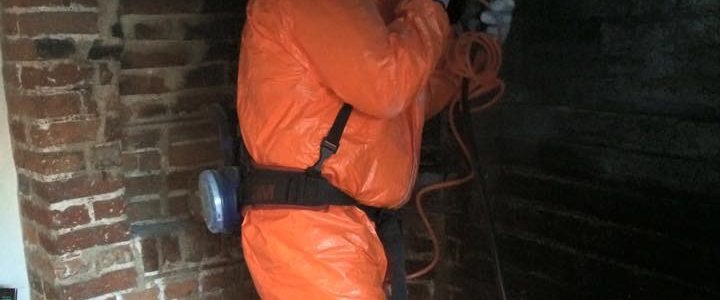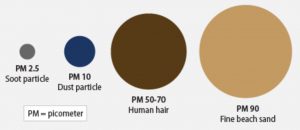Hello fellow Chimney Sweeps
Today I am writing this article in response to questions I have been asked on social media. The question is why do I need HEPA level filtration (High Efficiency Particulate Air) on my vacuum cleaner when I can buy a similar model which does not have a HEPA cartridge for very much less money.
In order for me to answer this question we must understand some things first: 1 what is soot?. 2 how bad is it for me? and 3 how big are the particles?
I will answer the question of how big are the particles first with help from the below illustration.
The size of a typical soot particle
Standard traditional filters are simply not fine enough to catch the fine particles. Soot particles are between PM 10 and PM 2.5 or smaller to make a comparison the thickness of a human hair is between PM 50 and PM 70. PM simply stands for picometer. The fine dust pollution that the government is concerned with at present is this exact same size. The primary airborne cause of this fine dust in the U.K. Is older diesel engines such as those found in cars, black cabs, busses, trains, lorries and to a lesser extent wood stoves.
A HEPA filter does not catch particles using a fine mesh or sieve as any meshing that fine would not allow a great enough airflow, instead HEPA generally uses electro static attraction, a process where particles are forced to change direction forcing them into the fibres or similar process. This is the reason that HEPA cartridges cannot be washed as the positive or negative charge or sticky ness of the filter is damaged or destroyed by the washing process and water.
HEPA filtration was invented for the nasty particles of the nuclear industry. Although HEPA is very good some VOCs are smaller still and require activated carbon filters to catch.
Answering the first question of how bad is soot for me is also asking what makes up the constituent parts of the products that we clean from our chimneys?
Soots constituents:
Simple Carbon, Acrolein, formaldehyde, xylene, benzene, toluene, naphthaline, other poly cyclic aromatic hydrocarbons and silicone.
As you can see in the list of parts there is some pretty high risk stuff in there many of which are in the highest risk`E` classification when doing your COSHH assessments even at concentrations of <1% of total product.
We should never forget that Soot is not black dirt, it is a byproduct of incomplete combustion and it really did kill of all of the chimney climbing boys
As a further tip bit of information the very first industrial disease studied was scrotal cancer caused by exposure to soot which was discovered by Mr Percivall Pott in 1755. Mr Pott was a surgeon in the United Kingdom his work eventually helped lead towards the chimney sweepers act in 1788
If you do some research you will see that much of the smell that comes from your vacuum is actually very fine particles of potentially very dangerous compounds these VOCs could be finding their way through your ineffective filters before being heated and in some cases vaporised and volitised by the hot motors. Associated with this are fine carbon particles which could also find their way into your lungs forever.
conclusion
Soot contains both carbon particles, fly ash and volatile organic compounds. The fine carbon particles < pm 10m are what is responsible in part to diseases such as chronic obstructive pulmonary disease and the VOCs are carcinogens. This is the 21st century we know better nowadays. Repeating the terrible days of the chimney boys is madness.
So in short buy a HEPA vacuum or upgrade yours with a HEPA cartridge, you will not stop every last voc particle with HEPA but you will limit your exposure and minimise the risks to yourself and your customers home.
Do not buy a vavuum that is Hepa like, purchase a True Hepa rated vacuum that is designed for soot particles, if you are unsure get something in writing from the manufacturer.
I hope that you have enjoyed my blog today and that if you one of those chimney sweeps that don’t yet use a Hepa vac maybe I have helped convince you.
Thanks for reading, please be so kind as to Like, Share and comment.
kindest regards
Daniel Hodgson








Leave a Reply